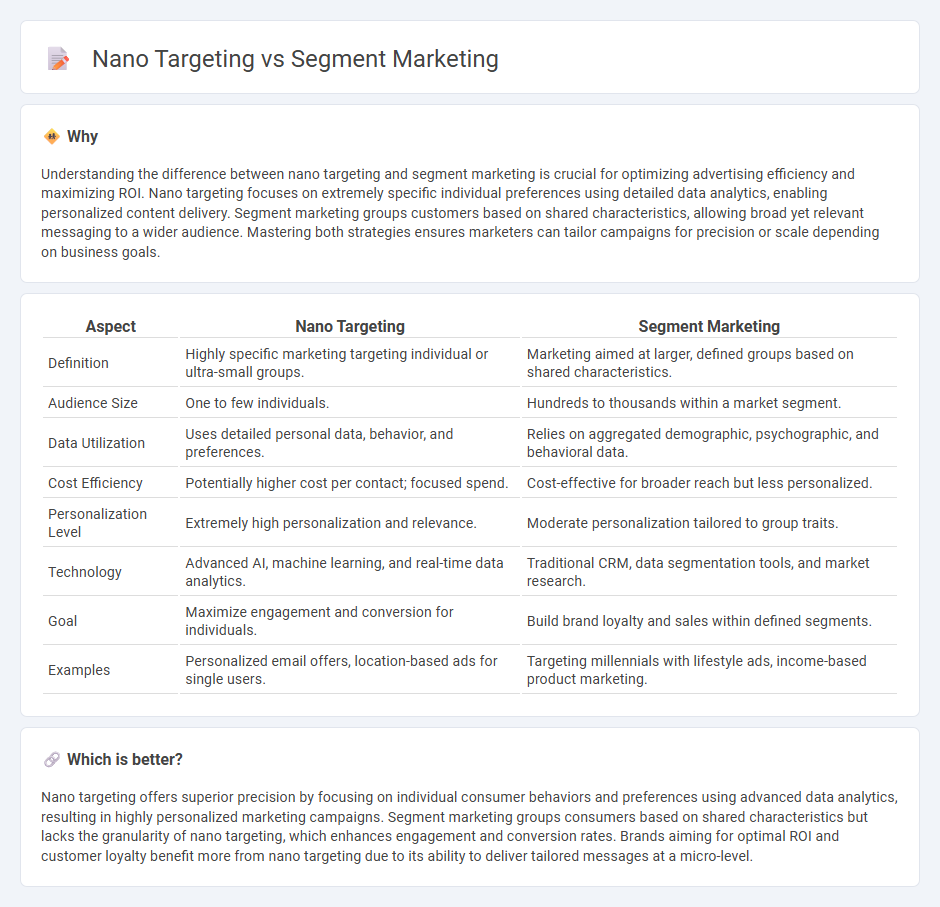
Nano targeting focuses on reaching highly specific individual consumers using precise data analytics and personalized content, enhancing engagement and conversion rates. Segment marketing groups audiences based on shared characteristics like demographics or behavior, enabling tailored messaging to broader categories with efficient resource allocation. Discover how leveraging nano targeting versus segment marketing can transform your advertising strategy.
Why it is important
Understanding the difference between nano targeting and segment marketing is crucial for optimizing advertising efficiency and maximizing ROI. Nano targeting focuses on extremely specific individual preferences using detailed data analytics, enabling personalized content delivery. Segment marketing groups customers based on shared characteristics, allowing broad yet relevant messaging to a wider audience. Mastering both strategies ensures marketers can tailor campaigns for precision or scale depending on business goals.
Comparison Table
| Aspect | Nano Targeting | Segment Marketing |
|---|---|---|
| Definition | Highly specific marketing targeting individual or ultra-small groups. | Marketing aimed at larger, defined groups based on shared characteristics. |
| Audience Size | One to few individuals. | Hundreds to thousands within a market segment. |
| Data Utilization | Uses detailed personal data, behavior, and preferences. | Relies on aggregated demographic, psychographic, and behavioral data. |
| Cost Efficiency | Potentially higher cost per contact; focused spend. | Cost-effective for broader reach but less personalized. |
| Personalization Level | Extremely high personalization and relevance. | Moderate personalization tailored to group traits. |
| Technology | Advanced AI, machine learning, and real-time data analytics. | Traditional CRM, data segmentation tools, and market research. |
| Goal | Maximize engagement and conversion for individuals. | Build brand loyalty and sales within defined segments. |
| Examples | Personalized email offers, location-based ads for single users. | Targeting millennials with lifestyle ads, income-based product marketing. |
Which is better?
Nano targeting offers superior precision by focusing on individual consumer behaviors and preferences using advanced data analytics, resulting in highly personalized marketing campaigns. Segment marketing groups consumers based on shared characteristics but lacks the granularity of nano targeting, which enhances engagement and conversion rates. Brands aiming for optimal ROI and customer loyalty benefit more from nano targeting due to its ability to deliver tailored messages at a micro-level.
Connection
Nano targeting leverages granular data to deliver personalized marketing messages to highly specific consumer segments identified through segment marketing. This approach enhances campaign precision by focusing on micro-segments defined by distinct behaviors, preferences, and demographics. Combining nano targeting with segment marketing maximizes ROI by increasing relevance and engagement within narrowly defined audience groups.
Key Terms
Demographics (for segment marketing)
Segment marketing divides audiences based on demographics such as age, gender, income, education, and location to create tailored campaigns addressing the specific needs and characteristics of each group. This approach enables businesses to efficiently allocate resources by targeting broad but distinct market segments with shared demographic profiles, improving messaging relevance and engagement rates. Explore how demographic insights enhance segment marketing effectiveness and drive strategic growth.
Psychographics (for segment marketing)
Psychographics in segment marketing analyze consumer attitudes, values, lifestyles, and personality traits to create meaningful groups that enhance targeted messaging and product positioning. Nano targeting hones in on ultra-specific audiences based on detailed behavioral and psychographic data, maximizing campaign precision and relevance for micro-segments. Explore the impact of psychographics on marketing strategy to optimize your campaign effectiveness.
Personalization (for nano targeting)
Segment marketing groups consumers based on shared characteristics, allowing tailored messaging for broad audiences, while nano targeting uses hyper-personalization by analyzing individual behavior, preferences, and real-time data to deliver highly specific content. Nano targeting leverages AI and data analytics to create unique consumer profiles, driving higher engagement and conversion rates through personalized experiences. Discover how nano targeting can transform your marketing strategy with its precision and personalized approach.
Source and External Links
What is Market Segmentation? A Guide - Market segmentation involves dividing a broader target market into smaller groups based on shared attributes to tailor marketing efforts more effectively.
Market Segmentation - Market segmentation is the process of dividing a market into meaningful sub-groups to target with distinct marketing strategies.
Mastering Your Market Segmentation Strategy: Tips and Best Practices - Market segmentation involves categorizing customers based on shared characteristics, behaviors, or other attributes to create tailored marketing strategies.
 dowidth.com
dowidth.com